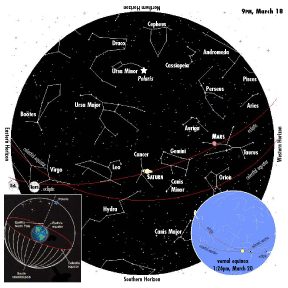The Precession of the Equinoxes
Celestial cycles create our seasons on earth
December’s solstice marked the shortest day as the sun traveled its lowest through our sky. Over that time, the sun has been bathing the Southern Hemisphere with more light than those of us north of the equator. All that changes with the vernal equinox Monday the 20th. On our first day of spring, the sun will rise due east and will set due west. and at precisely 1:26pm est, it will hover directly over the equator, dividing day and night into 12 hours each for every person on earth. Then the sun will inch northward until summer solstice as the whole process repeats itself.
All this is due to earth’s 231⁄2-degree tilted rotation. Earth spins on its axis with north and south pointed in fixed directions, north toward Polaris, the North Star. If the planet spun like a top with no wobble or tilt, we would have no seasons: the equator would receive the full brunt of the sun year-round, while the poles would receive no sunlight.
Astronomically, equinox is marked by the northward shift of the ecliptic in relation to the celestial equator. Of these two imaginary circles around the earth, the ecliptic is easy to pick out: it’s the path that the moon and planets travel in our night skies and that the sun travels in our daytime skies. The celestial equator, on the other hand, is more ethereal. Just as the earth's equator divides the planet into northern and southern hemispheres, so the celestial equator divides the sky, extending from earth’s equator outward into space. The points of the equinox year after year are not fixed in the heavens but move westward along the ecliptic, passing through different zodiacal constellations over the millennia, completing one cycle every 26,000 years in what is called the precession of the equinoxes.
